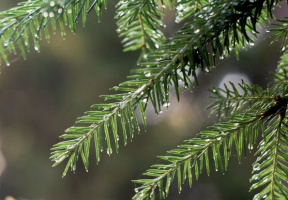
As shopping for live Christmas trees gets underway this holiday season, the tree experts at The Morton Arboretum recommend choosing one carefully and caring for it properly to ensure it stays fresh through the season. The Arboretum’s Plant Clinic provides free advice by phone or email for those with questions about how to care for trees and plants, including Christmas trees. Whether tree shoppers intend to have theirs up for six weeks or one week, Campbell offers these recommendations for keeping trees fresh.
Plan for watering. A cut evergreen tree needs water like flowers in a vase. Vessels where water flows are right under the tree’s bark, so it’s important to keep the bark undamaged. Tree stands should hold at least a gallon of water.
Buy a fresh tree. A more recently cut tree will provide greater time to enjoy it before it dries out and becomes a hazard. The freshest tree is one cut at the time of purchase from a choose-and-cut tree farm. Trees from small local lots are likely to have been harvested within a few days or weeks, making them fairly fresh. Wherever a tree is purchased, check it carefully for freshness.
Test for green, firm, flexible needles. To judge whether a tree is fresh, use a hand to gently brush a branch. If many needles fall off or if the needles feel stiff or crackly, the tree is dry and should not be bought. Needles on a fresh tree are plumped with water. They should be firmly attached, pliable and fragrant. It’s normal for an evergreen in autumn to lose some yellow or brown needles, but dropping a significant number of green needles is an indication the tree is drying out. Don’t buy a tree if the seller won’t let the customer unwrap it to examine its freshness.
Select a suitable species. Some evergreen species dry out more slowly and keep their needles longer than others. Needle types and branching forms also differ. Some types of trees have soft, bendy branches, while others have stiff branches that can support heavy ornaments. Among the species sold most often in the Chicago area are Fraser fir, balsam fir, concolor fir and Scots pine. Learn more about different kinds of Christmas trees on The Morton Arboretum website.
Fill it up. As soon as the tree is in place, fill the stand with warm tap water. Check the water at least twice daily and refill as necessary. Never allow the water level to fall below the bottom of the trunk. If the cut surface is exposed to air and seals with sap, the tree will not be able to absorb any more water.









